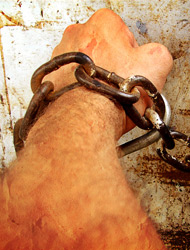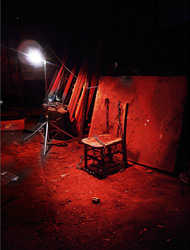- English
- Español
Fighting Human Trafficking in the Americas

The Palermo Protocols define trafficking as “the recruitment, transportation, transfer, harboring or receipt of persons, by means of the threat or use of force or other forms of coercion, of abduction, of fraud, of deception, of the abuse of power or of a position of vulnerability or of the giving or receiving of payments or benefits to achieve the consent of a person having control over another person, for the purpose of exploitation.”
The group traveled together, and they reached their destination safely. But instead of a movie set, they were taken to a house where their captors drugged them and sexually abused them. It was a trap, and the criminal organization that had brought them there was following an all-too-common script. “You still owe us the money we spent in bringing you here. So, if you want to see your family again, you will do everything we say,” they were told.
For four months, Marco was forced to prostitute himself. The money he earned was kept by his captors who claimed he still owed them thousands of dollars. His situation had no end in sight. Then one day, following an altercation with one of the members of the criminal gang, Marco managed to flee and sought refuge in a nearby church. When he told his story, he was referred to a shelter and support center for victims of human trafficking.
Though Marco’s story is somewhat unique because he is a man, the stories of women and children who are trafficked for the purpose of being sexually exploited are all too common in places around the world. At the time of Marco’s arrival in the shelter, a young woman of the same age, “Carla,” had escaped from a much longer ordeal, a two-year imprisonment in which she, too, was forced to prostitute herself.
Carla and Marco are survivors; their stories are not tragedies. Victims of human trafficking are widely diverse in age and national origin; many of them remain invisible to the authorities and beyond the reach of help. But governments, international organizations and civil society are playing important roles in finding them, prosecuting the culprits, and even giving survivors the tools they need to rebuild their lives. In some cases, they are succeeding.
The Organization of American States works closely with other international institutions, governments, and civil society in its member states to achieve these goals and prevent future criminal wrongdoing. Through its Department of Public Security in the Secretariat for Multidimensional Security and its Permanent Council’s Committee on Hemispheric Security, the OAS provides technical assistance, training and capacity building, and exchange of information and resources to contribute to the prevention, fight and eradication of this form of organized crime.
What is human trafficking?

Human trafficking is present in a variety of forms and has been seen in workplace exploitation, commercial sexual exploitation, forced marriage, sexual tourism, mendicity, and domestic service, among others.
That is why human trafficking is often referred to as a modern-day form of slavery. In 2000, the United Nations adopted the “Protocol to Prevent, Suppress and Punish Trafficking in Persons, especially Women and Children,” in Palermo, Italy, as part of its Convention against Transnational Organized Crime. This document came to be known as one of the “Palermo Protocols” or the “Trafficking Protocol,” and was the first legally binding instrument, at the global level, with a universal definition of the problem of human trafficking.
The Protocol aims at preventing, prosecuting and eradicating the crime of human trafficking by facilitating efficient international cooperation, and at protecting and assisting its victims. Its definition of trafficking in persons touches on the variety of ways in which people become victims of this crime all over the world.
There are currently 147 signatories and 159 parties to the Protocol, which entered into force in 2003 and has contributed to the establishment of national and regional laws for the prosecution of offenders; the exchange of information among nations; and a more unified approach in the prevention and eradication of human trafficking.
It is important to distinguish human trafficking from people smuggling. The latter refers to the transportation of a person across an international border in violation of a country’s laws, but usually with the consent of the person being smuggled. While trafficking “victims” or “survivors” may have been subjected to coercion or deception, people smuggling is usually the result of an outright contract between a smuggler and a customer and takes place with the full awareness and consent of the person being transported. The relationship ends upon arrival in the destination location where the migrant is typically looking for better life conditions, be they economic, political or otherwise. Finally, while payment given to a smuggler represents the primary source of profit in this kind of illegal enterprise, in human trafficking profits derive mainly from the prolonged exploitation of victims.
It is also worth highlighting the case of children. According to the UN Protocol quoted above, anyone under 18 years of age subjected to exploitation is to be considered a victim of human trafficking, whether or not any of the means included in its definition of human trafficking are involved.
How the OAS is fighting human trafficking
The OAS focuses its efforts in fighting human trafficking on three areas, the three P’s: Prevention, Prosecution of criminals, and Protection of victims. Through partnerships with non-governmental organizations and government at all levels in its member states, it provides training, exchange of information, and assists law enforcement agencies, immigration officers, judges, legislators, and others to create laws against human trafficking and to promote government initiatives tasked with identifying human trafficking cases, the prosecution of perpetrators, and the protection of victims.
In 2003, the OAS General Assembly adopted resolution 1948, “Fighting the Crime of Trafficking in Persons, especially Women, Adolescents, and Children,” a major step in strengthening its involvement at the inter-American level in preventing and combating this crime. Among other things, it instructed the General Secretariat of the OAS to facilitate information exchange and assist the member states in preventing and fighting this threat.
Today, the OAS provides training and assistance in the prevention of and fight against trafficking in persons to a variety of law enforcement officials in countries throughout the region. Its programs emphasize that this is a modern-day form of slavery and a violation of basic human rights, often involving coercive sexual exploitation, forced labor and involuntary servitude. One such OAS program, “Strengthening the Capacity of Law Enforcement Officials, Judges and Prosecutors in the Caribbean to Identify and Combat Trafficking in Persons, especially Women and Children,” run by the Department of Public Security, is being currently implemented in 13 English-speaking Caribbean countries. A two-day training seminar, led by OAS anti-trafficking-in-persons experts, looks at areas such as the distinction between trafficking and smuggling; crime scene management; victim identification, assistance and protection; standard operating procedures for immigration control; understanding the gender perspective as part of the human rights framework; and how trafficking in persons affects men, women, boys and girls in different ways. The OAS has also provided similar training to United Nations peacekeepers in five of the peacekeeping training centers of the Americas, and to consular and diplomatic officials of countries in the Americas before they were assigned to foreign missions around the world.
Most recently, in 2010, the OAS General Assembly endorsed the Work Plan against Trafficking in Persons in the Western Hemisphere, adopted by the Committee on Hemispheric Security, and urged member states to adopt measures to undertake the activities outlined in it. It also called upon other sectors of society to support such activities.
The Work Plan is meant to provide a frame of reference to guide actions by member states and the OAS General Secretariat in the areas of prevention, prosecution, and protection of victims from 2010 to 2012. It recommends possible activities for member states to undertake, including assessing the availability of legislation, policies or programs aimed at promoting human rights protection, reducing poverty and preventing violence against women and protecting children, as well as the identification of groups vulnerable to trafficking in persons and the development of protective measures, among others.
The Work Plan also mandates the OAS General Secretariat to develop materials to raise awareness and train security forces, law enforcement officers, immigration officers, prosecutors, and judges in the region; to identify opportunities to incorporate the issue of trafficking in persons and training modules into the curricula of police academies; to adopt measures for training justice system officials in matters related to trafficking in persons; and to present to member states a proposal for the establishment of national, sub-regional, and regional networks for the exchange of information on training and awareness programs.
A hopeful new beginning
Though human trafficking is a serious problem of global proportions, strategies adopted by the OAS and its partners are making a difference in the lives of many victims. It is not just a question of semantics to assert that through the joint work of local, regional and national governments with civil society organizations and international organizations like the OAS, “victims” of human trafficking are becoming “survivors,” and as such are able to find opportunities to rebuild their lives.
Today, “Carla” and “Marco,” are doing just that. Whilst in a shelter for victims of human trafficking, they received protection, counseling and educational support. In a matter of a few years, Marco has risen to the rank of manager of a local fast food restaurant. Carla, whose brutal ordeal involved forced prostitution at the age of 14, is currently attending a local community college and raising two children with her husband. More importantly, perhaps, is the knowledge that she is out of harm’s way and that someday she will be able to help vulnerable people as she once was. She is studying to become a social worker.


